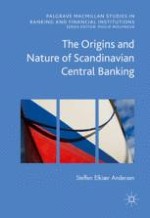2016 | OriginalPaper | Chapter
7. How the Great War Formed Scandinavian Central Banking
Author : Steffen Elkiær Andersen
Published in: The Origins and Nature of Scandinavian Central Banking
Publisher: Springer International Publishing
Activate our intelligent search to find suitable subject content or patents.
Select sections of text to find matching patents with Artificial Intelligence. powered by
Select sections of text to find additional relevant content using AI-assisted search. powered by
